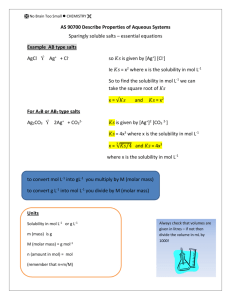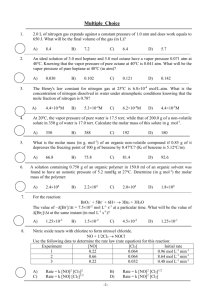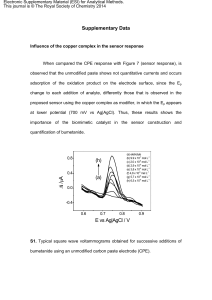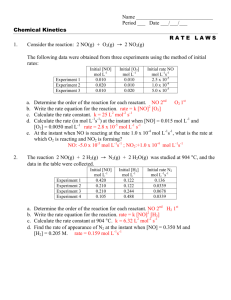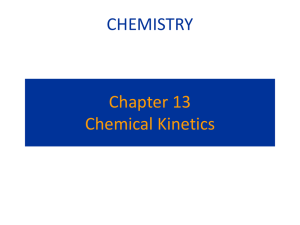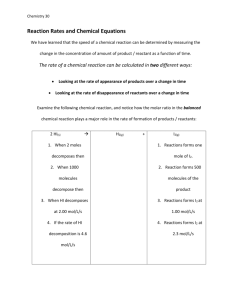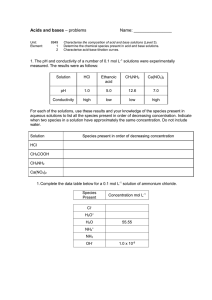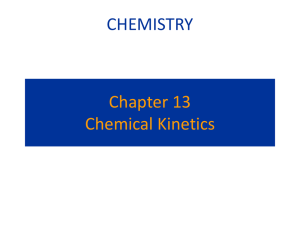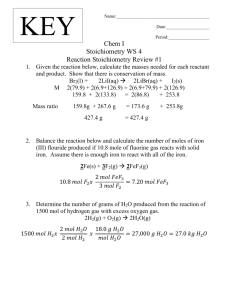AP Chemistry: Chemical Kinetics Worksheet
advertisement
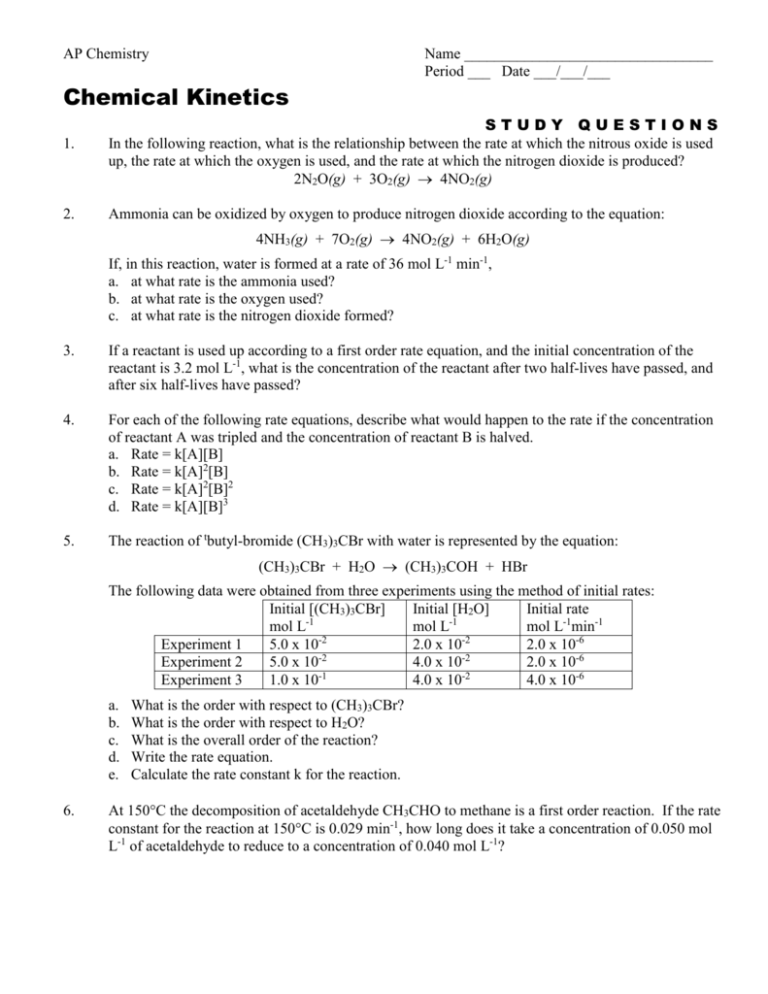
AP Chemistry Name _________________________________ Period ___ Date ___/___/___ Chemical Kinetics 1. STUDY QUESTIONS In the following reaction, what is the relationship between the rate at which the nitrous oxide is used up, the rate at which the oxygen is used, and the rate at which the nitrogen dioxide is produced? 2N2O(g) + 3O2(g) 4NO2(g) 2. Ammonia can be oxidized by oxygen to produce nitrogen dioxide according to the equation: 4NH3(g) + 7O2(g) 4NO2(g) + 6H2O(g) If, in this reaction, water is formed at a rate of 36 mol L-1 min-1, a. at what rate is the ammonia used? b. at what rate is the oxygen used? c. at what rate is the nitrogen dioxide formed? 3. If a reactant is used up according to a first order rate equation, and the initial concentration of the reactant is 3.2 mol L-1, what is the concentration of the reactant after two half-lives have passed, and after six half-lives have passed? 4. For each of the following rate equations, describe what would happen to the rate if the concentration of reactant A was tripled and the concentration of reactant B is halved. a. Rate = k[A][B] b. Rate = k[A]2[B] c. Rate = k[A]2[B]2 d. Rate = k[A][B]3 5. The reaction of tbutyl-bromide (CH3)3CBr with water is represented by the equation: (CH3)3CBr + H2O (CH3)3COH + HBr The following data were obtained from three experiments using the method of initial rates: Initial [(CH3)3CBr] Initial [H2O] Initial rate mol L-1 mol L-1 mol L-1min-1 Experiment 1 5.0 x 10-2 2.0 x 10-2 2.0 x 10-6 -2 -2 Experiment 2 5.0 x 10 4.0 x 10 2.0 x 10-6 Experiment 3 1.0 x 10-1 4.0 x 10-2 4.0 x 10-6 a. b. c. d. e. 6. What is the order with respect to (CH3)3CBr? What is the order with respect to H2O? What is the overall order of the reaction? Write the rate equation. Calculate the rate constant k for the reaction. At 150C the decomposition of acetaldehyde CH3CHO to methane is a first order reaction. If the rate constant for the reaction at 150C is 0.029 min-1, how long does it take a concentration of 0.050 mol L-1 of acetaldehyde to reduce to a concentration of 0.040 mol L-1? 7. The decomposition of hydrogen iodide into hydrogen and iodine is a second order reaction. The rate constant k = 0.080 L mol-1s-1. How long does it take an initial concentration of 0.050 M to decrease to half this concentration? 8. Describe some industrial uses of catalysts. 9. The gold-198 isotope has a half-life of 2.7 days. If you start with 10 mg at the beginning of the week, how much remains at the end of the week, seven days later? 10. If the rate of a reaction increases by a factor of 10 when the temperature is increased by 35C from 300K to 335K, what is the activation energy Ea for the reaction? 11. The decomposition of ozone in the upper atmosphere to dioxygen occurs by a two-step mechanism. The first step is a fast reversible step and the second is a slow reaction between an oxygen atom and an ozone molecule: Step 1: Step 2: O3(g) O2(g) + O(g) O3(g) + O(g) 2O2(g) Fast, reversible, reaction Slow a. Which is the rate determining step? b. Write the rate equation for the rate-determining step. c. Write the rate equation for the overall reaction. 12. The rate equation for the reaction of nitrogen dioxide and carbon monoxide in the gas state to form carbon dioxide and nitric oxide is represented by the equation: NO2(g) + CO(g) NO(g) + CO2(g) The following data were collected at 125C: Initial [NO2] mol L-1 Experiment 1 5.0 x 10-4 Experiment 2 5.0 x 10-4 Experiment 3 1.5 x 10-3 a. b. c. d. e. f. Initial [CO] mol L-1 1.6 x 10-2 3.2 x 10-2 3.2 x 10-2 What is the order with respect to NO2? What is the order with respect to CO? What is the overall order of the reaction? Write the rate equation. How do you know this is not a single step reaction? Suggest a mechanism for the reaction. Initial rate mol L-1min-1 1.7 x 10-7 1.7 x 10-7 1.5 x 10-6
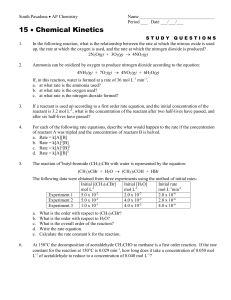
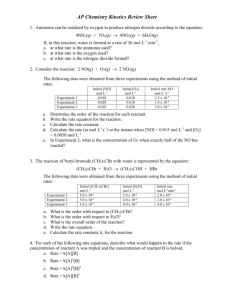
![Some Examples of Experimental Rate Laws Rate = k[A]](http://s3.studylib.net/store/data/008429765_1-55c81f2e6368c61bd42b7e157f3d34f1-300x300.png)
